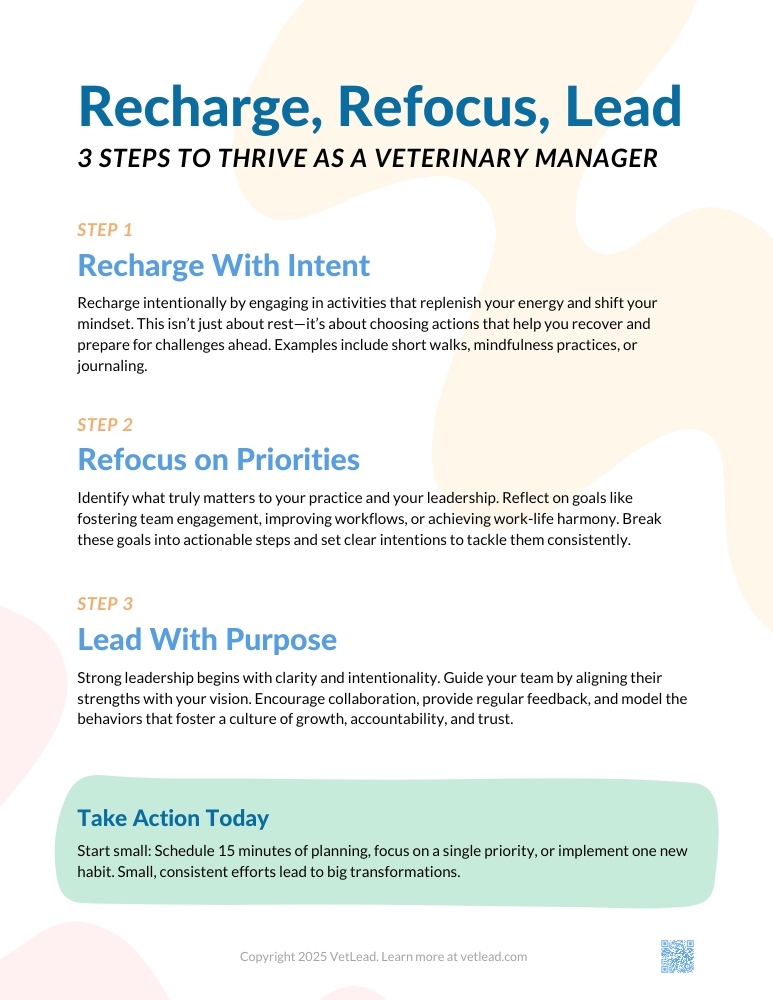Article Highlights
- Recharge Effectively: Learn how intentional habits can restore energy and focus.
- Refocus Your Leadership: Strategies to align your priorities with your goals.
- Lead with Impact: Build a thriving team and achieve work-life harmony.
Leadership in a veterinary practice is rewarding but demanding. Managing the needs of your team, patients, and clients can leave you feeling drained, making it harder to lead effectively. While the daily grind may seem relentless, learning how to recharge and refocus is essential—not just for your well-being but for your team’s success.
As a veterinary manager, recharging isn’t about taking a vacation you can’t afford or ignoring responsibilities. It’s about building intentional habits that restore your energy and sharpen your focus. Here’s how you can do that.
Why Recharging Matters in Leadership
Leading a team when you’re depleted is like trying to care for patients with an empty medical kit—it just doesn’t work. Exhaustion doesn’t just affect your mood; it impacts your ability to make decisions, communicate effectively, and inspire your team.
The Hidden Costs of Burnout
Burnout often begins with good intentions. You give everything to your role, putting out fires, meeting deadlines, and supporting others. But over time, neglecting your own needs takes a toll:
- Decision fatigue: Small choices feel overwhelming.
- Emotional withdrawal: Engaging with your team feels like a chore.
- Reduced empathy: Supporting others becomes harder when your energy is gone.
Recognizing these signs early is key to avoiding burnout. Recharging ensures you show up at your best, ready to support your team and make meaningful decisions.
Check out Randy's recent live event recording, How to Change a Toxic Culture in Your Veterinary Practice.
Step 1: Recharge With Intent
Recharging goes beyond physical rest—it’s about engaging in meaningful activities that restore both your energy and sense of control. Think of it as refueling your internal resources so you can approach challenges with clarity and resilience.
Differentiate Recharging from Escaping
Escaping feels good in the moment but doesn’t solve the underlying problem. Think of mindless scrolling or binge-watching TV. These activities distract you temporarily but leave your challenges unresolved. Recharging, on the other hand, restores your mental, emotional, and physical capacity:
- Recharging activities: Going for a walk, meditating, or journaling.
- Escaping activities: Hours of social media or endlessly streaming content.
When you recharge, your brain is better equipped to find solutions, process emotions, and focus on what matters most.
Build Recharge Habits
Start by scheduling small, achievable recharging moments into your week. For instance:
- 5 minutes of mindfulness breathing: Reset your focus during busy shifts.
- Daily walks: Even a quick loop around the building can clear your head.
- Journaling once a week: Reflect on what’s working and where you need support.
These practices don’t need to take hours; they need to become consistent habits.
Step 2: Refocus on What Matters
Recharging creates space for clarity. Once you’ve replenished your energy, use it to refocus on priorities that drive meaningful results for your team and practice.
Define Success for Yourself and Your Team
What does a thriving veterinary practice look like? Take a moment to envision the outcomes you want. These could be a fully engaged team that communicates and collaborates effectively, workflows that reduce stress while improving patient care, or a sense of work-life harmony that supports both your professional and personal goals. When you can clearly picture these goals, you’re better equipped to make them a reality.
Refocusing helps you identify what truly matters. Without this clarity, it’s easy to get bogged down in reactive tasks that don’t move you or your practice forward.
Align Your Focus With Intentional Planning
Effective leaders don’t wing it—they plan with purpose. Dedicate 15 minutes daily to plan:
- Your team’s goals: What needs to be accomplished today, this week, or this month?
- Your leadership priorities: Which team members need your support most?
- Your personal growth: What skill or habit do you want to improve this quarter?
Intentional planning ensures that your time and energy are spent on high-impact areas.
Step 3: Lead With Energy
Once you’ve recharged and refocused, you’re in a better position to lead. Leadership is about creating an environment where others can thrive, and your energy sets the tone for the entire team.

Download this Accompanying PDF Now
Share it with leaders and teams. No email address required.
Show Up With Positivity
Your attitude is contagious. When you lead with optimism and accountability, it signals to your team that challenges can be overcome. Even small acts, like celebrating wins during huddles or acknowledging personal growth, can boost morale and engagement.
Incorporate Recharge Practices for Your Team
A thriving culture begins with collective well-being. Encourage your team to embrace recharging habits:
- Introduce short breaks during long shifts to prevent fatigue.
- Create a quiet space in the practice for moments of mindfulness.
- Share ideas for personal and professional development during team meetings.
When your team sees you prioritizing well-being, they’re more likely to do the same.
Support Individual Growth
Engaged teams are built on progress. Regular one-on-one conversations allow you to:
- Discuss career goals and development opportunities.
- Address challenges and brainstorm solutions together.
- Build trust by showing genuine interest in their success.
By focusing on your team’s growth, you create an environment where everyone feels valued and motivated.
Achieving Work-Life Harmony
Balancing work and life isn’t about treating them as separate, competing forces. Instead, it’s about finding harmony, where both aspects support each other. Reflect on what energizes you at work—perhaps it’s tasks that bring you satisfaction or interactions that inspire you.
Consider what fulfills you outside of work, such as hobbies, meaningful relationships, or activities that help you recharge. Finally, think about how these areas can complement each other. Professional achievements can enhance personal fulfillment, just as your personal life can provide the energy and perspective needed to succeed at work.
Work-life harmony helps you sustain long-term happiness as a leader, making you more effective and fulfilled.
Take the First Step Today
Being a veterinary manager means navigating challenges daily, but you don’t have to do it on empty. By intentionally recharging, refocusing, and leading with energy, you can create a fulfilling, sustainable leadership experience for yourself and your team.
Start small:
- Schedule a 10-minute walk today.
- Plan tomorrow’s priorities before leaving work.
- Share one encouraging observation with your team.
These small steps build momentum, helping you lead with clarity, confidence, and a renewed sense of purpose.
Ready to explore more ways to thrive as a veterinary manager? The Veterinary Leadership Program offers actionable strategies, live coaching, and resources to help you succeed. Learn more and take the next step in your leadership journey today.

